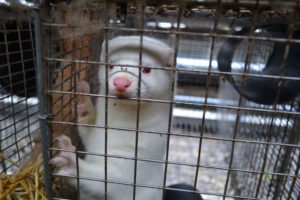

SARS-CoV-2 not only infects humans but can also spread occasionally from humans to cats, dogs, and tigers. A recent addition to this menagerie is the farmed mink.
In mid-April 2020 mink on two farms in the Netherlands developed signs of respiratory disease which included nasal discharge and respiratory distress. Examination of the lungs revealed interstitial pneumonia and alveolar damage. RT-PCR showed the presence of SARS-CoV-2 RNA in the lung and in throat and rectal swabs of multiple animals. Phylogenetic analysis demonstrated that the outbreaks on the two farms were a consequence of two separate introductions of virus.
To understand the origin of the mink infections, farm owners and their families were interviewed. An individual on one farm had undiagnosed respiratory symptoms while on the other farm one person had been hospitalized with COVID-19. These observations suggest that humans transmitted infections to mink.
Because multiple animals were infected on each farm, environmental studies were done to understand the source of virus. Inhalable dust in the air of the mink houses was found to contain SARS-CoV-2 RNA. It seem likely that after introduction of the virus from humans into one or more mink, they shed virus into the room and it was transmitted it to other animals.
Subsequently outbreaks of SARS-CoV-2 in minks have been identified in four additional farms in the Netherlands. In addition, at least two farm workers appear to have acquired SARS-CoV-2 infection from farmed minks. Furthermore, some mink may be asymptomatically infected. It appears likely that the virus might establish a reservoir in farmed minks from where it could repeatedly infect other minks, humans and other animals such as cats. Consequently the Netherlands government has decided to cull all mink on infected farms. As fur farming will be banned in the country as of 2024, this might be a good time for mink farmers to cease their operations. It will be of interest to determine if SARS-CoV-2 infection of mink occurs in other countries. More broadly, what other mammals can be infected with the virus?

I would assume they have the same ACE receptors as humans.
Never heard of a virus going from zoo to human, then back to zoo.
Guess anything is possible with this strain. Coronaviruses are very flexible.